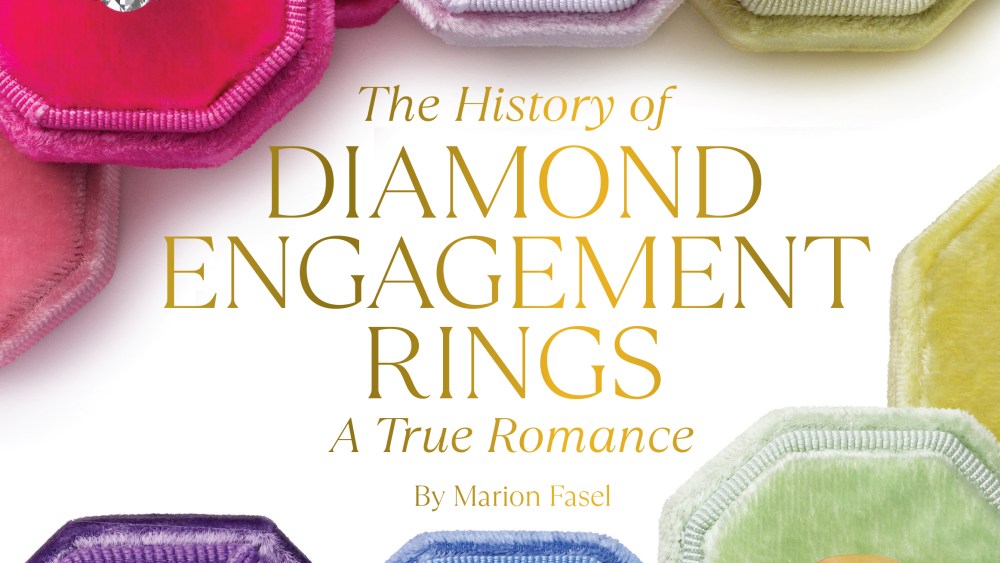Regardless if jewelry is your thing, there is a piece of adornment every person knows: the engagement ring. It spawns obsessive deep dives on social media, is entrenched in culture, found in films, and is the focal point of multimillion-dollar advertising campaigns — “A diamond Is Forever” among them. But does anyone truly know the why?
Marion Fasel, jewelry expert and founder of online fine jewelry magazine The Adventurine, now has written a book, “The History of Diamond Engagement Rings: A True Romance,” that unpacks the — longer than one might think — history of the cherished piece.
Presented by Only Natural Diamonds — which supported the production process, as it did with Assouline’s “Diamonds: Diamond Stories” — the limited-edition, hardcover, small-format book lushly and meticulously takes readers on a journey through the history of the engagement ring, setting up the story through diamond cuts reaching back to the 15th century.
“I have always been fascinated by bridal because engagement rings, it is the one thing that almost everyone can identify with when talking about fine jewelry,” said Fasel, who spent years at InStyle magazine, helping to set the bar for fashion magazines’ fine jewelry coverage. “When I moved online with The Adventurine, the numbers of people that were interested in engagement ring stories were always so high. It outnumbers anything else.”
While there is full attention on the topic, few understand the history. Fasel candidly said that she, too, wasn’t exactly sure about the story and she wasn’t alone. “When I went to my go-to experts in history and asked, ‘Do you know the history of diamond engagement rings?” It was “no.”
Author and jewelry expert Marion Fasel.
Andrew Werner
Creating the tome led her on a nine-month odyssey via her computer, exploring the archives of the world’s celebrated cultural institutions, from the Victoria and Albert Museum in London to the Vatican. The first person she spoke to, gem dealer Benjamin Zucker, became her guide in the process, she said. Zucker kicked things off in the book’s foreword writing about seeing and collecting pointed diamonds from the 15th century and earlier — a point that helped Fasel to unlock a myth that engagement rings are an invention of the 20th century. “There is misconception that it was a niche practice until 1947, when De Beers promoted it in an advertising campaign with the tagline ‘A Diamond Is Forever,’” she writes in the book’s introduction.
She begins in the 15th century with the first solitaires, remarking that the true beginning isn’t known, debunking another misconception that there was an actual “first” diamond engagement ring in 1477 when Archduke Maximilian I of Austria gave Mary of Burgundy a diamond ring. “That’s not true,” Fasel said point blank. “It’s all over the internet and it’s jumped into some books. But there is a document in the Vatican that has a wedding that predates that by about three years, which is in the book.”
Using vibrant imagery — from the Renaissance to Grace Kelly to Beyoncé — she charts the jewel’s lineage. There is a Renaissance design with the Latin inscription “I am a token of love,” a 1920 Tiffany setting and an early Asscher cut in an ornate platinum ring made around 1915, a mid-20th century emerald-cut diamond ring, and a contemporary cushion-cut diamond and gold ring — each adding a new layer to the tale.
While historical, the real driver of the book is her style guides, which highlight the vocabulary of diamonds, diagramming the parts of rings. “I thought you need to see those drawings alongside the rings because I feel that chronology is almost impossible to do in any jewelry history period, because you’re never going to be able to fill in everything,” she explained.
Across the pages there is “a constant connection and conversation” between the engagement rings of the past and the present “which, of course, I did not know was going to happen,” she said. An example: an image of Gloria Swanson behind lace in a 1924 Edward Steichen photograph wearing her large oval diamond engagement, an iconic image of the Art Deco period.
It’s a page after a photo of Lady Gaga at the 2024 Venice International Film Festival wearing an oval diamond engagement ring and black lace Philip Treacy headpiece. “I showed that to a few people, and they were like, ‘Oh, she must have known that. She must have planned it.’ I was like, look, everyone I’ve shown that Steichen picture to says, ‘I never saw the ring.’
“We talk about symbolism so much in jewelry today,” she continued. “It’s such a focus of trends. But what is the most powerful symbolic jewel in the history of the world? It’s a diamond engagement ring and it has been consistently worn for 500 years.”
The book debuts Monday on Amazon, naturaldiamonds.com and select jewelry retailers across the U.S.

